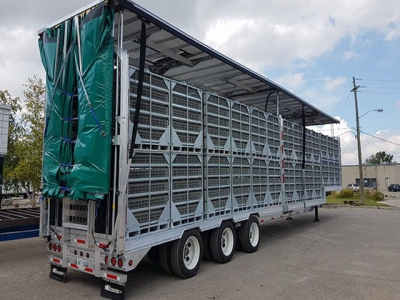5 technologies that may improve broiler welfare

Poultry transport trailers utilizing removable, fabric sidewalls to protect the animals from exposure may see wider adoption in the industry in the near future. | Photo courtesy Curtainsider Inc.
A Tyson Foods leader on animal welfare shared her thoughts on innovative concepts that will likely change broiler animal welfare in the near future.
Consumers are demanding greater animal welfare as part of enhanced food industry transparency, so the poultry industry will need to start looking for novel ways to boost broiler welfare outcomes.
Dr. Karen Christensen, senior director of animal wellbeing for Tyson Foods Inc., discussed five concepts that will likely change the way the poultry industry does business with respect to animal welfare. Christensen spoke on March 13 as part of the 2018 Midwest Poultry Federation Convention in Minneapolis.
Christensen said a lot of the ideas are still in the concept phase but her company, as well as the industry, needs to seriously consider the changes and how they might be implemented in the future.
“I’m really interested in seeing these things being brought to a commercial level so we really have a chance to not only really evaluate them in a commercial setting but then really the option to absolutely incorporate them,” Christensen said.
1. Imaging and audio technology
Imaging technology is advancing rapidly and is creating new opportunities to observe animal behaviors and characteristics without the need to be physically present in the broiler house. Christensen pointed specifically to imaging and audio technology that could be used to quickly collect information on animal welfare. The goal is to understand what the animals need, respond to those needs almost instantaneously and reduce negative interactions between people and the birds.
Specific technologies utilizing thermal imaging can examine things like eye temperature to understand the level of stress the birds are under or observe leg temperature to gauge joint inflammation. Burgeoning audio technology can study what noises the animals are making and interpret it so farmers can better understand if the birds are under stress, or possibly even if they are feeling too hot or too cold.
Christensen mentioned research being done by Marian Dawkins, a professor of animal behavior at the University of Oxford, on the concept of optical flow applied to a poultry house setting.
Có thể bạn quan tâm
 How Thailand is fighting poultry disease with technology
How Thailand is fighting poultry disease with technology Community engagement and a clever phone app are helping to control poultry and other livestock diseases in Thailand.
 Salmonella, Campylobacter infection routes in broilers
Salmonella, Campylobacter infection routes in broilers The pathogenic bacteria can spread through a number of bodily routes and infect a large portion of the flock if unchecked.
 4 key factors to reduce necrotic enteritis in broilers
4 key factors to reduce necrotic enteritis in broilers Necrotic enteritis can be caused by a multitude of factors, but focusing on chick quality, diet, vaccination and bird management can mitigate risk.